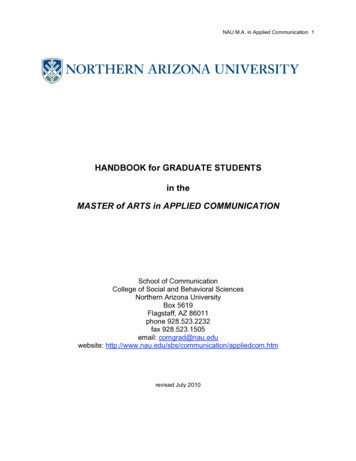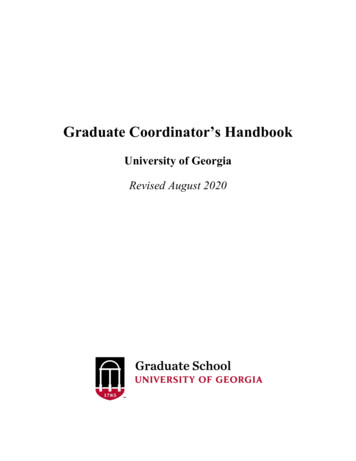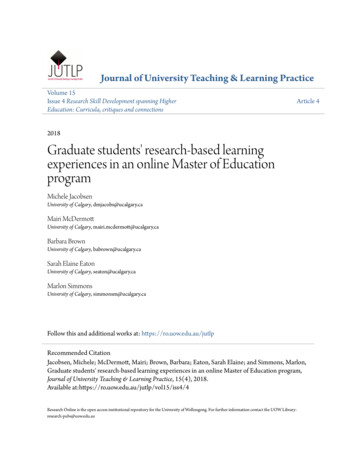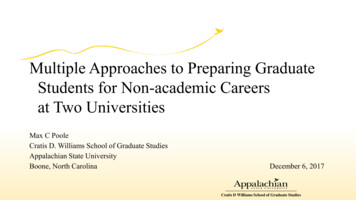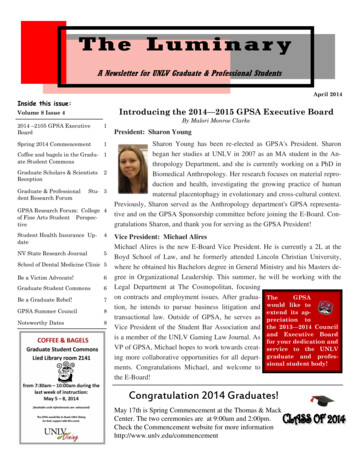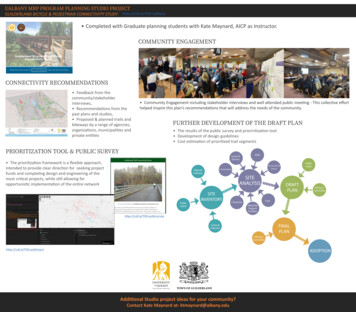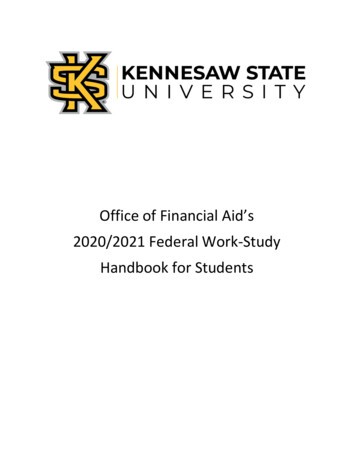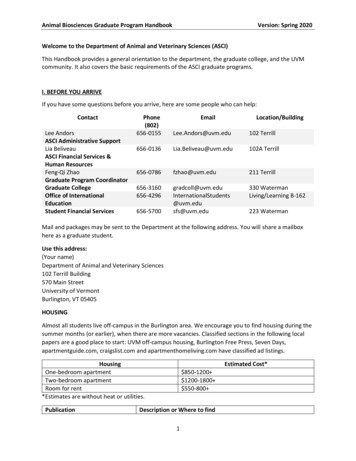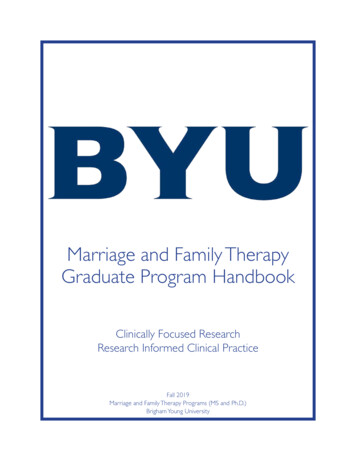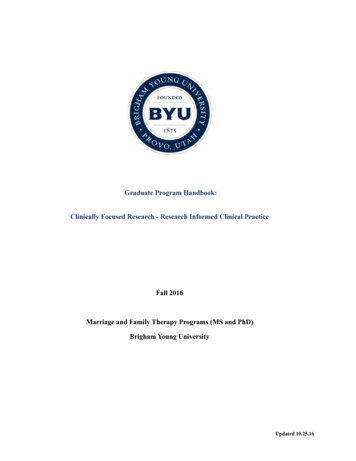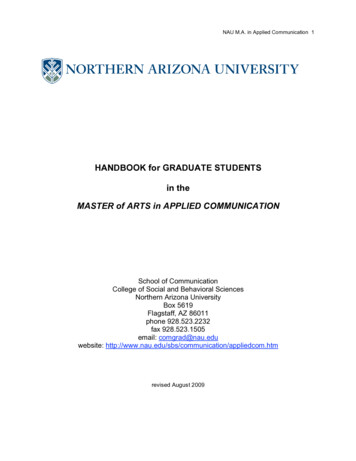
Transcription
NAU M.A. in Applied Communication 1HANDBOOK for GRADUATE STUDENTSin theMASTER of ARTS in APPLIED COMMUNICATIONSchool of CommunicationCollege of Social and Behavioral SciencesNorthern Arizona UniversityBox 5619Flagstaff, AZ 86011phone 928.523.2232fax 928.523.1505email: comgrad@nau.eduwebsite: mrevised August 2009
NAU M.A. in Applied Communication 2Table of ContentsDescription of Master of Arts in Applied Communication Program.3Introduction .3Graduate Study in Communication .3Degree Requirements and Procedures.4General Degree Requirements .4Part-time and Full-time Status .5Continuous Enrollment Policies.6Time Limits .7University Degree Requirements .7Enrollment Status .7Transfer Credit and Requirements .8Grade Point Average Requirements.8In Progress .9Incomplete.9Additional Policies and Information.10Selecting an Advisor and Graduate Committee .10Temporary Advisor .10Selecting a Permanent Advisor .10Selecting a Graduate Committee.11Working with Your Advisor and Committee in the Summer .12Degree Options .12Choosing Projects or a Thesis.13Projects Option.14Thesis Option .18Levels of Evaluation .22Annual Graduate Student Review.23Application for a Degree and Graduation.23Appeals and Grievances.25Academic Appeals .25Appeals of Graduate Regulations .25Grievances.25Safe Working and Learning Environment.25Student Anti-retaliation Policy .25Graduate Assistantships, Scholarships, and Travel Awards.26Appendix A: Graduate Program Worksheet.28Appendix B: Suggestions for Preparing a Project Proposal .29Appendix C: Suggestions for Preparing a Prospectus .30Appendix D: Format for Project Title Page.32Appendix E: Graduate Course Descriptions .33Appendix F: Master of Arts in Applied Communication Graduate Faculty.35
NAU M.A. in Applied Communication 3DESCRIPTION OF MASTER OF ARTS IN APPLIED COMMUNICATION PROGRAMINTRODUCTIONThe Master of Arts in Applied Communication (MAAC) is housed in the School ofCommunication, a unit within the College of Social and Behavioral Sciences at NorthernArizona University. The M.A. in Applied Communication is designed to provide studentswith advanced skills in communication analysis, problem solving, critical thinking,research, theoretical application, and written communication.This handbook is intended as a description of graduate work in the program, as well asa guide to aid you in your progress through the program once you begin. Thishandbook is only suggestive and is not intended to represent all policies andprocedures. Be aware that policies of NAU’s Graduate College, Northern ArizonaUniversity, and the Arizona Board of Regents supercede any material found herein,although every effort is made to ensure that this handbook is consistent with universityand state policies.Please refer to NAU’s Graduate College Policies (http://home.nau.edu/gradcol/) and therelevant NAU Catalog atalogs.htm) for governing requirements and policies.If you need further explanation of anything here, you should contact your graduateadvisor or the MAAC Graduate Coordinator (comgrad@nau.edu).GRADUATE STUDY IN COMMUNICATIONTo study communication is to study a variety of forms of human symbolic behavior thatoccurs in interpersonal, small group, organizational, mediated, and public situations.Communication is central to forming relationships, organizing collective behaviors,maintaining and changing cultures, making sense of our social and natural worlds, andfostering understanding among people; it is a fundamental part of our human nature.The study of human communication is based on the assumption that our ability tocommunicate in an effective and ethical manner is vital to productive human interaction.Communication scholars are committed to the idea that exploration of diverseunderstandings of communicative behavior enriches our participation in an increasinglycomplex and interdependent global society.As a student in the M.A. in Applied Communication program, you articulate and testyour ideas, develop individual abilities, and gain competence in various communicativesettings. You acquire knowledge and methods that apply to nearly every aspect of yourprivate and public lives—in the classroom as well as outside it. In consultation with youradvisor, you can design a program to meet your interests and needs. Graduate work incommunication is rigorous and challenging. You are required to design, carry out, andpresent independent research. In doing so, you refine skills in writing, critical thinking
NAU M.A. in Applied Communication 4and reasoning, presentation and defense of ideas, application of theory to everydaysituations, and research. An advanced degree is proof that you are capable ofdesigning and following through on projects expected of communication experts.Although the time involved will vary among individual students based on their existingskills, knowledge, and abilities, a typical three-credit graduate-level course offered in astandard sixteen-week format will generally require nine to twelve (9-12) hours of workeach week (including in-class time or the online equivalent, reading, writing, outsideresearch, preparation for in-class activities, et cetera). Summer courses generallyinvolve twenty to thirty (20-30) hours of work each week depending on the length of thecourse. In addition, completion of a thesis or two projects should involve 270 hours (ormore) of sustained work.Students who graduate with an M.A. in Applied Communication from Northern ArizonaUniversity are fully prepared to enter a doctoral program (in communication or relatedfields) or to gain employment inside or outside higher education. Our graduate programis small enough to guarantee close contact between faculty and students and largeenough to offer a wide variety of experiences for students, including the opportunity toteach, attend and present at professional conferences, and apply classroom knowledgeto improve real-world situations.As a graduate student, it is your responsibility to consult with your advisor to develop anappropriate plan of study. You must take the initiative in making sure that your planmeets the requirements of NAU’s Graduate College and the M.A. in AppliedCommunication. However, this handbook should give you some direction, andremember—your advisor is available to help, as is the Graduate Coordinator for theM.A. in Applied Communication.DEGREE REQUIREMENTS AND PROCEDURESGENERAL DEGREE REQUIREMENTSA minimum of thirty-six (36) credit hours is required for graduation with an M.A. inApplied Communication, at least fifteen (15) of which must be numbered 600 or above.All students must also complete at least twenty-four (24) credit hours of formal coursework selected in consultation with their graduate advisor—that is, courses other thansuch individualized studies as independent studies, directed readings, research, thesis,and projects. All requirements for the master's degree must be completed within sixyears.All students are required to take three courses comprising nine (9) credit hours: COM 600 (Communication Theory and Application), COM 601 (Research Methods in Communication), and COM 698 (Seminar in Communication Theory).In addition, Graduate Teaching Assistants are required to take SC 503 (Classroom
NAU M.A. in Applied Communication 5Communication).All students are required to complete twenty-one (21) credit hours of electives, whichare selected in consultation with their advisor. Up to nine (9) credit hours outside ofCommunication (COM) and Speech Communication (SC) may be selected inconsultation with a faculty advisor to use as electives in your degree program. Inaddition, the NAU Graduate College allows up to six (6) credits of 400-level courses tocount toward completion of your program of study, with advisor approval (400-levelcourses are generally only allowed when a corresponding graduate-level course is notavailable during the course of your studies). Finally, students who have a taken aspecific 400-level course at NAU are generally not allowed to count that course’s 500level counterpart as part of their graduate degree program.(If you have your advisor’s approval to take a 400-level course, you and your advisormust complete the “Out of Career Enrollment Authorization” section of the “OverrideAuthorization - Audit/Class Links/Out-of-Career” form and submit it to the Registrar afteryou have enrolled for the class and before you complete the class. This form can beobtained from the Registrar at http://home.nau.edu/registrar/forms.asp. Withoutcompleting this form, you will be allowed to enroll for the class and receive a grade, butthe course will not count toward your graduate degree.)All students must select a thesis or projects option (described later in this document).Six (6) credits of thesis (COM 699) or project (COM 690) are required, though you mayend up registering for more than six of these credits (as explained later in thisdocument).In Appendix A of this handbook, we have provided a Graduate Program Worksheet foryou to use to keep track of your progress and plan your upcoming course registration.In Appendix E of this handbook you will find descriptions of the graduate-level courseswe offer. Please be aware that our graduate courses are offered under two prefixes:COM (Communication) and SC (Speech Communication).Part-time and Full-time StatusStudents enrolled in the M.A. in Applied Communication have the option of attendingfull- or part-time. Full-time students normally take three or four classes per semester (912 credits) for up to four semesters. Part-time students generally take fewer credits,usually one or two classes (3-6 credits) each semester. If you are only taking coursesvia distance (online), then in most semesters you will only be able to register on a parttime basis. We do not guarantee sufficient course offerings for distance students tocomplete the program on a full-time basis.The MAAC program is committed to offering a minimum of one web course and one"block" course (in which students meet once a week, face-to-face, seminar style) or web
NAU M.A. in Applied Communication 6hybrid course (in which online assignments replace some of the traditional classroomtime) each semester. Generally the block and web hybrid courses are offered in thelate afternoon or evening. Other courses are offered in a co-convened format, in whicha 400-level (undergraduate) course and its 500-level (graduate) counterpart are taughttogether. In addition, graduate courses are typically offered during the summer term,usually by web delivery.Normally, full-time students can expect to complete their graduate program in two years(four semesters), depending on the number of credits taken each semester andsufficient progress toward completion of a thesis or projects. Part-time students canexpect to complete their course work in six to eight semesters (approximately three tofour years) or more, again depending on the number of credits taken each semesterand sufficient progress toward completion of a thesis or projects.Continuous Enrollment PoliciesYou are expected to pursue your graduate degree with a minimum of interruption andmaintain continuous enrollment. If you are in a master’s degree program and do notenroll for three consecutive semesters (not including summer), you will be consideredwithdrawn from the university and must reapply for readmission to resume your degreeprogram.If you choose to take courses in some terms (semesters) but not others, you shouldfamiliarize yourself with NAU’s policies regarding continuous enrollment. If you arecurrently enrolled at NAU or if you have previously attended and have been inattendance for one or more of the previous three fall or spring terms or any interveningsummer or winter terms, NAU considers you a continuing student for course enrollmentpurposes. This means you need not apply for readmission to the university. As acontinuing student, you may enroll during any of the published course enrollmentperiods. If you have not earned credits from NAU for more than three consecutiveterms (excluding summer and winter terms), you must apply for readmission to NAU. Ifyou attend NAU only during summer and/or winter terms, you are considered acontinuing student if you attend at least one course in each successive (annual)summer and/or winter term from your point of admission.Even after you have completed all formal courses required for your degree, you mayneed to use university facilities to carry out a required independent study, thesisresearch, and/or projects. For the protection of both you and the university, NAUrequires that you be enrolled for credit during any term that you use university facilitiesor require the professional time of faculty members. This includes work on your thesis(COM 699) or projects (COM 690).Continuous Enrollment Relating to Master’s Theses (COM 699). When you beginworking on a master’s thesis (COM 699), the Graduate College expects you to enrolleach semester from the time you begin this work until completion of your degree. You
NAU M.A. in Applied Communication 7must register for a minimum of one (1) credit each fall and spring semester. If you areusing research or other university facilities, and/or the professional time of facultymembers, you should enroll for at least three (3) units. During the term you completeand defend your thesis (even if this will be in the summer term), you must enroll for atleast three (3) units to reflect the increased demands on the time of both faculty and thestaff of the Graduate College.If you do not maintain continuous enrollment after your work has begun on yourmaster’s thesis and you do not have an approved leave of absence on file with theGraduate College and wish to resume work, you must submit a new application foradmission and register for additional credits of thesis (COM 699) in an amount equal tothe number of such credits missed while not maintaining continuous enrollment.To avoid having to sign up for additional credits after the term in which you defend, youmust submit the final approved copies of your thesis to the Graduate College by the lastday of the term in which you complete your defense. If you do not meet this deadline,you must enroll for three (3) credits of thesis (COM 699) credit each term after yourdefense until you submit your final copies to the Graduate College. For moreinformation, see the Thesis Requirements in the Graduate Degree Requirementssection of the NAU academic catalog.Leave of Absence. In extenuating circumstances, you may petition for exception to thecontinuous enrollment policy. The petition form, which is available on the graduatecollege website (http://home.nau.edu/gradcol/), must be approved by your advisor andthe MAAC Graduate Coordinator and sent to the Associate Dean of the GraduateCollege for final approval. Your request must be filed and approved before theanticipated absence.Time LimitsYou must complete all requirements for your master's degree within a six-year period. Ifyou take courses from other institutions and transfer them to your program at NAU, theymust also be taken within the six-year period. The six-year period begins at the start ofthe semester in which you take your first course (including transfer courses).UNIVERSITY DEGREE REQUIREMENTSEnrollment StatusNAU defines full-time enrollment for graduate students as nine (9) credits during fall andspring terms and the 10-week summer session. The minimum full-time course load isnine (9) credits during fall or spring term, and 16 credits is the maximum (12 credits forgraduate assistants). You cannot take more than six (6) credits during any five-weeksummer session or more than three (3) credits during the pre-session.
NAU M.A. in Applied Communication 8You can only carry an overload (more than the maximum units as explained in theprevious paragraph) with the approval of your advisor, the Director of the School ofCommunication, and the Associate Dean of the Graduate College. To enroll for anoverload, you must submit the appropriate approval form when you enroll. This form isavailable from the Graduate College (http://home.nau.edu/gradcol).Transfer Credit and RequirementsIf you have been admitted to our graduate program and have earned resident graduatecredit at another institution, you can petition the Graduate College to apply such credittoward your graduate degree. Only courses deemed by your advisor to be relevant toyour program of study will be accepted.Transferring credits to a graduate degree program is not done routinely. To beconsidered for transfer credit, NAU requires that your courses must: have been earned at a regionally accredited institution, have been earned with a grade of A or B (NAU will accept a pass grade if thecourse is graded only on a pass-fail basis), have been earned within the six-year period required for completing yourmaster’s degree at NAU, be applicable to a graduate degree at the institution where the credit was earned,and meet the Arizona Board of Regents’ requirement for credit: A minimum of 45hours of work i
NAU M.A. in Applied Communication 1 HANDBOOK for GRADUATE STUDENTS in the MASTER of ARTS in APPLIED COMMUNICATION School of Communication College of Social and Behavioral Sciences Northern Arizona University Box 5619 Flagstaff, AZ 86011 phone 928.523.2232
